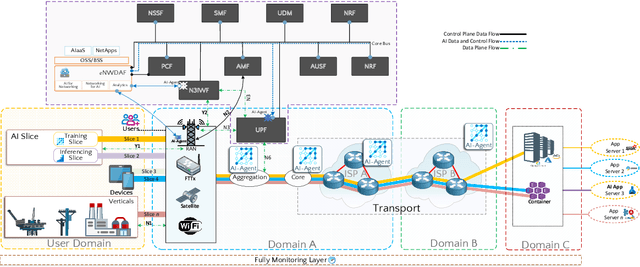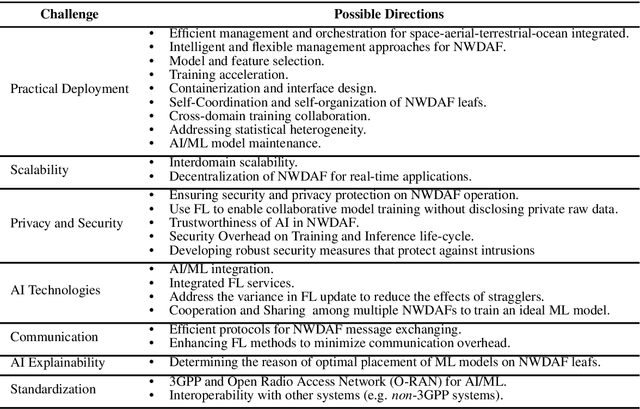Rodrigo Moreira
Performance Evaluation and Threat Mitigation in Large-scale 5G Core Deployment
Jul 23, 2025Abstract:The deployment of large-scale software-based 5G core functions presents significant challenges due to their reliance on optimized and intelligent resource provisioning for their services. Many studies have focused on analyzing the impact of resource allocation for complex deployments using mathematical models, queue theories, or even Artificial Intelligence (AI). This paper elucidates the effects of chaotic workloads, generated by Distributed Denial of Service (DDoS) on different Network Functions (NFs) on User Equipment registration performance. Our findings highlight the necessity of diverse resource profiles to ensure Service-Level Agreement (SLA) compliance in large-scale 5G core deployments. Additionally, our analysis of packet capture approaches demonstrates the potential of kernel-based monitoring for scalable security threat defense. Finally, our empirical evaluation provides insights into the effective deployment of 5G NFs in complex scenarios.
Towards Sustainability in 6G Network Slicing with Energy-Saving and Optimization Methods
May 17, 2025Abstract:The 6G mobile network is the next evolutionary step after 5G, with a prediction of an explosive surge in mobile traffic. It provides ultra-low latency, higher data rates, high device density, and ubiquitous coverage, positively impacting services in various areas. Energy saving is a major concern for new systems in the telecommunications sector because all players are expected to reduce their carbon footprints to contribute to mitigating climate change. Network slicing is a fundamental enabler for 6G/5G mobile networks and various other new systems, such as the Internet of Things (IoT), Internet of Vehicles (IoV), and Industrial IoT (IIoT). However, energy-saving methods embedded in network slicing architectures are still a research gap. This paper discusses how to embed energy-saving methods in network-slicing architectures that are a fundamental enabler for nearly all new innovative systems being deployed worldwide. This paper's main contribution is a proposal to save energy in network slicing. That is achieved by deploying ML-native agents in NS architectures to dynamically orchestrate and optimize resources based on user demands. The SFI2 network slicing reference architecture is the concrete use case scenario in which contrastive learning improves energy saving for resource allocation.
VINEVI: A Virtualized Network Vision Architecture for Smart Monitoring of Heterogeneous Applications and Infrastructures
Dec 26, 2024Abstract:Monitoring heterogeneous infrastructures and applications is essential to cope with user requirements properly, but it still lacks enhancements. The well-known state-of-the-art methods and tools do not support seamless monitoring of bare-metal, low-cost infrastructures, neither hosted nor virtualized services with fine-grained details. This work proposes VIrtualized NEtwork VIsion architecture (VINEVI), an intelligent method for seamless monitoring heterogeneous infrastructures and applications. The VINEVI architecture advances state of the art with a node-embedded traffic classification agent placing physical and virtualized infrastructures enabling real-time traffic classification. VINEVI combines this real-time traffic classification with well-known tools such as Prometheus and Victoria Metrics to monitor the entire stack from the hardware to the virtualized applications. Experimental results showcased that VINEVI architecture allowed seamless heterogeneous infrastructure monitoring with a higher level of detail beyond literature. Also, our node-embedded real-time Internet traffic classifier evolved with flexibility the methods with monitoring heterogeneous infrastructures seamlessly.
* 12 pages
Improving the network traffic classification using the Packet Vision approach
Dec 26, 2024



Abstract:The network traffic classification allows improving the management, and the network services offer taking into account the kind of application. The future network architectures, mainly mobile networks, foresee intelligent mechanisms in their architectural frameworks to deliver application-aware network requirements. The potential of convolutional neural networks capabilities, widely exploited in several contexts, can be used in network traffic classification. Thus, it is necessary to develop methods based on the content of packets transforming it into a suitable input for CNN technologies. Hence, we implemented and evaluated the Packet Vision, a method capable of building images from packets raw-data, considering both header and payload. Our approach excels those found in state-of-the-art by delivering security and privacy by transforming the raw-data packet into images. Therefore, we built a dataset with four traffic classes evaluating the performance of three CNNs architectures: AlexNet, ResNet-18, and SqueezeNet. Experiments showcase the Packet Vision combined with CNNs applicability and suitability as a promising approach to deliver outstanding performance in classifying network traffic.
* 6 pages
Improving Sickle Cell Disease Classification: A Fusion of Conventional Classifiers, Segmented Images, and Convolutional Neural Networks
Dec 23, 2024



Abstract:Sickle cell anemia, which is characterized by abnormal erythrocyte morphology, can be detected using microscopic images. Computational techniques in medicine enhance the diagnosis and treatment efficiency. However, many computational techniques, particularly those based on Convolutional Neural Networks (CNNs), require high resources and time for training, highlighting the research opportunities in methods with low computational overhead. In this paper, we propose a novel approach combining conventional classifiers, segmented images, and CNNs for the automated classification of sickle cell disease. We evaluated the impact of segmented images on classification, providing insight into deep learning integration. Our results demonstrate that using segmented images and CNN features with an SVM achieves an accuracy of 96.80%. This finding is relevant for computationally efficient scenarios, paving the way for future research and advancements in medical-image analysis.
* 14 pages
Towards Cognitive Service Delivery on B5G through AIaaS Architecture
Dec 23, 2024


Abstract:Artificial Intelligence (AI) is pivotal in advancing mobile network systems by facilitating smart capabilities and automation. The transition from 4G to 5G has substantial implications for AI in consolidating a network predominantly geared towards business verticals. In this context, 3GPP has specified and introduced the Network Data Analytics Function (NWDAF) entity at the network's core to provide insights based on AI algorithms to benefit network orchestration. This paper proposes a framework for evolving NWDAF that presents the interfaces necessary to further empower the core network with AI capabilities B5G and 6G. In addition, we identify a set of research directions for realizing a distributed e-NWDAF.
* 8 pages
On Enhancing Network Throughput using Reinforcement Learning in Sliced Testbeds
Dec 21, 2024



Abstract:Novel applications demand high throughput, low latency, and high reliability connectivity and still pose significant challenges to slicing orchestration architectures. The literature explores network slicing techniques that employ canonical methods, artificial intelligence, and combinatorial optimization to address errors and ensure throughput for network slice data plane. This paper introduces the Enhanced Mobile Broadband (eMBB)-Agent as a new approach that uses Reinforcement Learning (RL) in a vertical application to enhance network slicing throughput to fit Service-Level Agreements (SLAs). The eMBB-Agent analyzes application transmission variables and proposes actions within a discrete space to adjust the reception window using a Deep Q-Network (DQN). This paper also presents experimental results that examine the impact of factors such as the channel error rate, DQN model layers, and learning rate on model convergence and achieved throughput, providing insights on embedding intelligence in network slicing.
Evaluating the Potential of Federated Learning for Maize Leaf Disease Prediction
Dec 10, 2024



Abstract:The diagnosis of diseases in food crops based on machine learning seemed satisfactory and suitable for use on a large scale. The Convolutional Neural Networks (CNNs) perform accurately in the disease prediction considering the image capture of the crop leaf, being extensively enhanced in the literature. These machine learning techniques fall short in data privacy, as they require sharing the data in the training process with a central server, disregarding competitive or regulatory concerns. Thus, Federated Learning (FL) aims to support distributed training to address recognized gaps in centralized training. As far as we know, this paper inaugurates the use and evaluation of FL applied in maize leaf diseases. We evaluated the performance of five CNNs trained under the distributed paradigm and measured their training time compared to the classification performance. In addition, we consider the suitability of distributed training considering the volume of network traffic and the number of parameters of each CNN. Our results indicate that FL potentially enhances data privacy in heterogeneous domains.
An Intelligent Native Network Slicing Security Architecture Empowered by Federated Learning
Oct 04, 2024Abstract:Network Slicing (NS) has transformed the landscape of resource sharing in networks, offering flexibility to support services and applications with highly variable requirements in areas such as the next-generation 5G/6G mobile networks (NGMN), vehicular networks, industrial Internet of Things (IoT), and verticals. Although significant research and experimentation have driven the development of network slicing, existing architectures often fall short in intrinsic architectural intelligent security capabilities. This paper proposes an architecture-intelligent security mechanism to improve the NS solutions. We idealized a security-native architecture that deploys intelligent microservices as federated agents based on machine learning, providing intra-slice and architectural operation security for the Slicing Future Internet Infrastructures (SFI2) reference architecture. It is noteworthy that federated learning approaches match the highly distributed modern microservice-based architectures, thus providing a unifying and scalable design choice for NS platforms addressing both service and security. Using ML-Agents and Security Agents, our approach identified Distributed Denial-of-Service (DDoS) and intrusion attacks within the slice using generic and non-intrusive telemetry records, achieving an average accuracy of approximately $95.60\%$ in the network slicing architecture and $99.99\%$ for the deployed slice -- intra-slice. This result demonstrates the potential for leveraging architectural operational security and introduces a promising new research direction for network slicing architectures.
* 18 pages, 12 figures, Future Generation Computer Systems (FGCS)
Intelligent Data-Driven Architectural Features Orchestration for Network Slicing
Jan 12, 2024Abstract:Network slicing is a crucial enabler and a trend for the Next Generation Mobile Network (NGMN) and various other new systems like the Internet of Vehicles (IoV) and Industrial IoT (IIoT). Orchestration and machine learning are key elements with a crucial role in the network-slicing processes since the NS process needs to orchestrate resources and functionalities, and machine learning can potentially optimize the orchestration process. However, existing network-slicing architectures lack the ability to define intelligent approaches to orchestrate features and resources in the slicing process. This paper discusses machine learning-based orchestration of features and capabilities in network slicing architectures. Initially, the slice resource orchestration and allocation in the slicing planning, configuration, commissioning, and operation phases are analyzed. In sequence, we highlight the need for optimized architectural feature orchestration and recommend using ML-embed agents, federated learning intrinsic mechanisms for knowledge acquisition, and a data-driven approach embedded in the network slicing architecture. We further develop an architectural features orchestration case embedded in the SFI2 network slicing architecture. An attack prevention security mechanism is developed for the SFI2 architecture using distributed embedded and cooperating ML agents. The case presented illustrates the architectural feature's orchestration process and benefits, highlighting its importance for the network slicing process.
 Add to Chrome
Add to Chrome Add to Firefox
Add to Firefox Add to Edge
Add to Edge